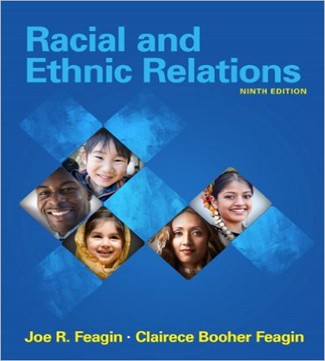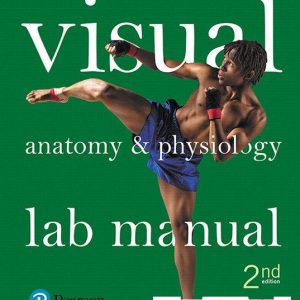Instant download Racial and Ethnic Relations 9th Edition Feagin Feagin Test Bank pdf docx epub after payment.

Part 1
The Racial and Ethnic Mosaic
Chapter 1
Basic Concepts in the Study of Racial and Ethnic Relations
CHAPTER OUTLINE
I. Issues of Race and Racism
Racial Groups and Racialized Hierarchies
Ideological Racism
Racial Groups
Ancestry and Multiracial Realities
II. Ethnic Groups
What Is an Ethnic Group?
III. A Note on Cultures
IV. A Racial Framing of Society
V. Prejudices and Stereotypes
Explanations of Stereotyping and Prejudice
Are Racial Perspectives and Performances Changing?
VI. Discrimination
Distinguishing Dimensions
Research on Prejudice and Discrimination
Defining Institutional and Individual Discrimination
The Sites and Range of Discrimination
Cumulative and Systemic Discrimination
Responding to Discrimination
Conservative Reactions to Antidiscrimination Programs
VII. Summary
VIII. Key Terms
CHAPTER OBJECTIVES
* Why did the United States begin as a country that was substantially democratic but also rooted in racial oppression?
* Why and how have human beings developed the powerful ideas of “race” and ethnicity?
* How does racial or ethnic discrimination become institutionalized?
* How do people respond to racial and ethnic oppression in the United States?
CLASSROOM DISCUSSION TOPICS
* What are the problems with describing the United States as just a “nation of immigrants”?
* How has the concept of “race” as a biologically distinctive category changed, or not changed, over several centuries?
* How is the concept of “race” understood presently by almost all social scientists?
* How has the racial framing of this society been maintained and reworked from the seventeenth century to the present day?
* What are common methods of developing and rationalizing stereotypes and prejudices?
* How do stereotypes and prejudices maintain racial and ethnic discrimination?
* What is the relevance of the four types of discrimination discussed to present-day racial relations
in the United States?
TEST ITEMS
A. Identify or define each term clearly and completely as it relates to this course.
1. Racial hierarchy (5) 9. Isolate discrimination (20)
2. Racialization (6) 10. Stereotyping (15)
3. Racism (5-6) 11. Discrimination (18-23)
4. Racial group (8) 12. Direct institutionalized discrimination (21)
5. Ethnic group (10) 13. Indirect institutionalized discrimination (21)
6. Prejudice (14) 14. Systemic discrimination (22)
7. Racial frame (13) 15. Cumulative discrimination (22)
8. Small group discrimination (20)
B. True/False
F 16. In postrevolutionary U.S. history, non European immigrants were the only incoming groups who faced discrimination and oppression. (1)
T 17. An early draft of the Declaration of Independence denounced slavery and blamed it on the English king. (1)
T 18. Jefferson was a major slaveholder who received much wealth and prosperity from the oppressive, slaveholding agricultural system. (2)
F 19. Because of the principle that “all men are created equal,” which is stated in the Declaration of Independence and the protections contained in the Bill of Rights, black slavery in the U.S. disappeared much more rapidly than it did in Britain. (2)
T 20. The earliest use of the term race referred to descendants of a common ancestor, emphasizing kinship linkages rather than physical characteristics. (5)
T 21. The often darker-skinned people from Africa and Native American societies were relegated by European observers to the bottom, in part because they were subordinated by whites. (5)
T 22. Ideological racism is an ideology that considers a group’s unchangeable physical characteristics to be linked in a direct, causal way to psychological or intellectual characteristics, and that on this basis distinguishes between superior and inferior racial groups. (6)
F 23. One’s race is determined solely by physical characteristics such as skin color that clearly indicate biological inferiority or superiority. (7)
F 24. It is easy to distinguish people of different races today because of the high consistency of uniformity of physical characteristics associated with all races. (7)
F 25. In general, subordinate groups have a high level of control over how their group is viewed by the dominant group in their society. (12)
T 26. A stereotype is an overgeneralization associated with a racial or ethnic category that goes beyond existing evidence. (15)
T 27. One source of racial stereotyping and prejudice is the dominant group’s need to rationalize the oppression of a subordinate group. (16)
F 28. Those with authoritarian personalities are characterized by great concern for equality, status, and a view of the world as non-threatening to groups that occupy a socially subordinate position. (16)
T 29. According to social psychologist Philomena Essed, racism involves individual discriminators whose specific actions are racist only when they activate existing structural racial inequalities in the system. (20)
F 30. A nonwhite worker who is laid off because he or she lacks seniority which he or she could not accumulate because of the company’s past discriminatory hiring practices is the victim of isolate discrimination. (20)
F 31. Indirect institutionalized discrimination is directly based on prejudice or intent to harm members of the outgroup. (21)
T 32. Covert discrimination is difficult to document and prove. (22)
C. Multiple Choice: Select the one best answer to each item.
33. In the Atlantic coast colonies (1)
a. the language spoken was predominantly English although the social and economic institutions did not follow any European national pattern.
b. the social and economic institutions were most heavily influenced by the French.
* c. the basic social institutions were predominantly English.
d. all European national groups were encouraged to keep their own language and social institutions.
34. Thomas Jefferson removed his denunciation of slavery from his early draft of the Declaration of Independence (1)
a. because of pressure from King George who declared that he was not in fact responsible for slavery in the colonies.
b. because he himself had slaves.
c. because slaves had been freed and the denunciation was obsolete.
* d. because of pressure from southern slave holders and New England slave traders.
35. The original U.S. Constitution (2)
a. contained no formal recognition of race subordination.
* b. required that fugitive slaves be returned to their owners.
c. abolished the slave trade.
d. provided that all persons, slave or free, be counted equally for purposes of apportioning legislative representation and taxation.
36. The Alien, Sedition, and Naturalization Acts, passed in the late 1700s and early 1800s, were aimed basically at excluding or restricting immigrants from (2)
a. Africa.
b. China and Japan.
c. England.
* d. Ireland, France, and Germany.
37. A Naturalization Act passed in the late 1700s (2)
a. encouraged all new immigrants to become naturalized citizens as quickly as possible.
b. established a one year residency requirement for citizenship.
* c. increased the residency requirement for citizenship from 5 to 14 years.
d. declared that no immigrants from non European countries could become citizens.
38. Which of the following used the term race simply to emphasize kinship linkages rather than physical characteristics? (5)
* a. 16th- and 17th-century Europeans
b. Immanuel Kant
c. late 18th- and 19th-century physical anthropologists
d. Count de Gobineau, Madison Grant, and German Nazis
39. Racialization can be seen as the process by which (6)
a. those in the subordinate group place themselves as a means of resistance.
* b. the dominant white group has defined and constructed certain groups as being racially inferior or superior for the purposes of societal placement and of group enrichment, segregation, or oppression.
c. unchangeable physical characteristics can be linked in a direct, causal way to psychological or intellectual characteristics and, on this basis, distinguishes between superior and inferior racial groups.
d. observed cultural differences are used as a method of linking external differences to intrinsic characteristics.
40. The one most important reason why certain selected physical characteristics such as skin color have been used as the basis for distinguishing human groups is (8)
a. these characteristics are easily observable by all persons.
b. dark skin color is an unmistakable mark of inferiority.
c. skin color is an unmistakable indicator of racial ancestry.
* d. some clear signal was needed to identify the exploited group.
41. The rule of descent as used in assigning individuals to a racial group determines descent (8-9)
* a. by the socially defined race of the person’s ancestors.
b. scientifically.
c. by place of birth.
d. by the nationality of the person’s family name.
42. The term ethnic group (10)
a. means exactly the same as race.
b. is used only to distinguish groups on the basis of race, religion, and nationality.
c. refers only to non white groups.
* d. is used by some social scientists to distinguish groups on the basis of cultural or nationality characteristics.
43. A minority group (12)
a. often has as much power as the majority group in a society.
* b. is singled out by the dominant group on the basis of physical or cultural traits.
c. seldom has a sense of collective identity.
d. is always fewer in number than the dominant group.
44. An organized set of racial ideas, narratives, stereotypes, images, emotions, and inclinations to discriminate is known as (13)
a. ideological racism.
b. racial hierarchy.
* c. racial frame.
d. covert discrimination.
45. In both popular usage and social science analysis, prejudice means (14)
a. the same thing as discrimination.
b. the same thing as a stereotype.
* c. an antipathy based on an inaccurate or inflexible generalization.
d. the same thing as ethnocentrism.
46. “Modern racism” is characterized by (16-17)
* a. resistance to large scale racial integration.
b. serious, overt antiblack discrimination.
c. rigid segregation.
d. extreme antiblack stereotypes.
47. The process of making blatantly racist commentaries and performances, such as racist joking or frequent use of racist epithets, when in settings with friends and relatives is known as (17-18)
a. modern racism.
b. discrimination.
c. stereotyping.
* d. backstage racism.
48. Which of the following is NOT a key dimension of discrimination? (18)
* a. manipulation
b. motivation
c. discriminatory actions
d. effects
49. According to Allport, many prejudiced people (19)
a. keep their prejudices to themselves.
* b. act out their prejudices in various ways.
c. have never met a member of an outgroup.
d. avoid discriminatory behavior because they fear disapproval by the dominant group.
50. Researchers have found that (19-20)
a. white discrimination against blacks is more likely to occur in face to face encounters than in anonymous situations.
b. all whites openly express their prejudices in opinion surveys.
* c. white discrimination against blacks is more common than opinion surveys predict.
d. white discrimination against blacks is rare.
51. If a white Anglo police officer implements anti-Latino hostility by beating up Mexican American prisoners, even though the majority of Anglo officers and department regulations specifically oppose such actions, this officer is participating in (20)
a. institutional racism.
* b. isolate discrimination.
c. backstage racism.
d. ultimate attribution error.
52. Well-institutionalized patterns of discrimination that cut across major political, economic, and social organizations in a society can be termed_____? (22)
a. subtle discrimination
b. racist ideology
* c. systemic discrimination
d. racial framing
53. True reverse discrimination would mean that people of color in the United States (24)
a. constitute a growing proportion of students at formerly all white colleges.
* b. have the power and institutional position to express their prejudices against whites.
c. are prejudiced against whites.
d. hold a growing proportion of jobs formerly held by white men.





